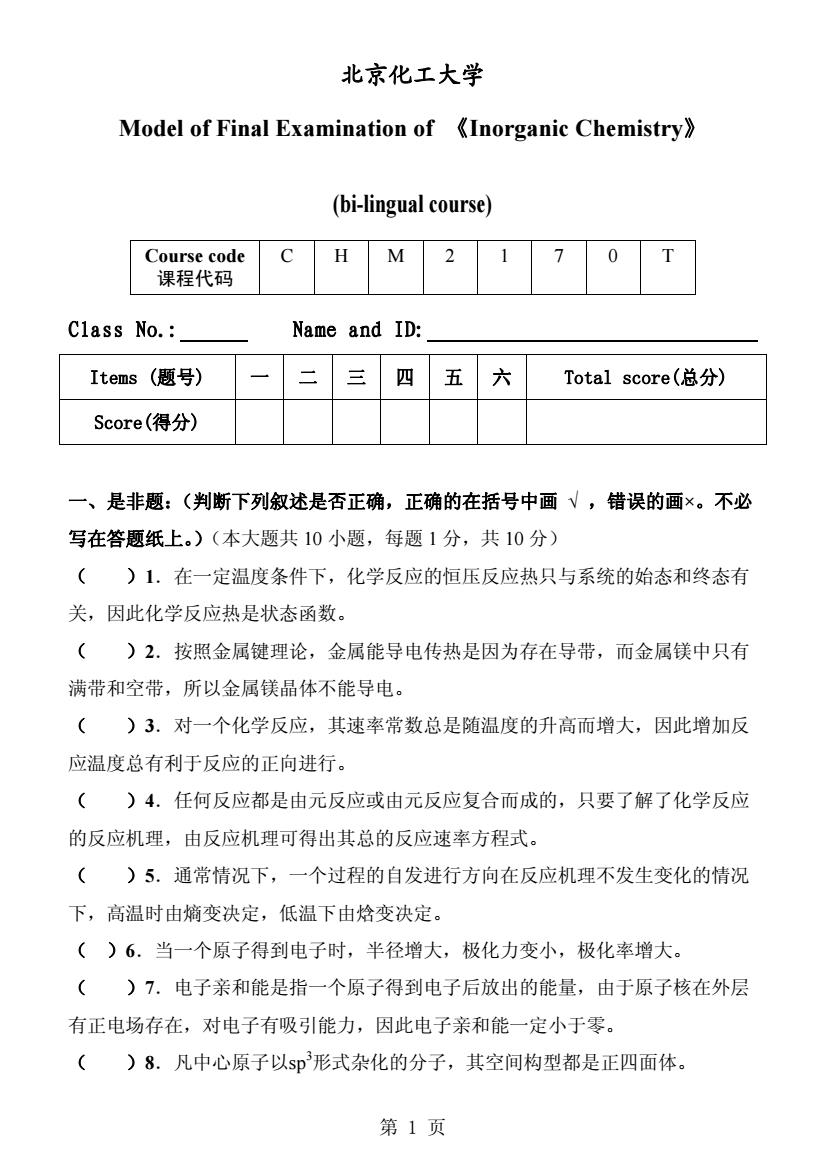
北京化工大学 Model of Final Examination of <Inorganic Chemistry) (bi-lingual course) Course code CH M217 0T 课程代码 Class No.: Name and ID: Items(题号) 二三四五六 Total score(总分) Score(得分) 一、是非题:(判断下列叙述是否正确,正确的在括号中画√,错误的画×。不必 写在答题纸上。)(本大题共10小题,每题1分,共10分) ()1.在一定温度条件下,化学反应的恒压反应热只与系统的始态和终态有 关,因此化学反应热是状态函数。 ()2.按照金属键理论,金属能导电传热是因为存在导带,而金属镁中只有 满带和空带,所以金属镁晶体不能导电。 ()3.对一个化学反应,其速率常数总是随温度的升高而增大,因此增加反 应温度总有利于反应的正向进行。 ()4.任何反应都是由元反应或由元反应复合而成的,只要了解了化学反应 的反应机理,由反应机理可得出其总的反应速率方程式。 ()5.通常情况下,一个过程的自发进行方向在反应机理不发生变化的情况 下,高温时由熵变决定,低温下由焓变决定。 ()6.当一个原子得到电子时,半径增大,极化力变小,极化率增大。 ()7.电子亲和能是指一个原子得到电子后放出的能量,由于原子核在外层 有正电场存在,对电子有吸引能力,因此电子亲和能一定小于零。 ()8.凡中心原子以$p形式杂化的分子,其空间构型都是正四面体。 第1页
北京化工大学 Model of Final Examination of 《Inorganic Chemistry》 (bi-lingual course) Course code 课程代码 C H M 2 1 7 0 T Class No.: Name and ID: Items (题号) 一 二 三 四 五 六 Total score(总分) Score(得分) 一、是非题:(判断下列叙述是否正确,正确的在括号中画 √ ,错误的画×。不必 写在答题纸上。)(本大题共 10 小题,每题 1 分,共 10 分) ( )1.在一定温度条件下,化学反应的恒压反应热只与系统的始态和终态有 关,因此化学反应热是状态函数。 ( )2.按照金属键理论,金属能导电传热是因为存在导带,而金属镁中只有 满带和空带,所以金属镁晶体不能导电。 ( )3.对一个化学反应,其速率常数总是随温度的升高而增大,因此增加反 应温度总有利于反应的正向进行。 ( )4.任何反应都是由元反应或由元反应复合而成的,只要了解了化学反应 的反应机理,由反应机理可得出其总的反应速率方程式。 ( )5.通常情况下,一个过程的自发进行方向在反应机理不发生变化的情况 下,高温时由熵变决定,低温下由焓变决定。 ( )6.当一个原子得到电子时,半径增大,极化力变小,极化率增大。 ( )7.电子亲和能是指一个原子得到电子后放出的能量,由于原子核在外层 有正电场存在,对电子有吸引能力,因此电子亲和能一定小于零。 ( )8.凡中心原子以sp3 形式杂化的分子,其空间构型都是正四面体。 第 1 页
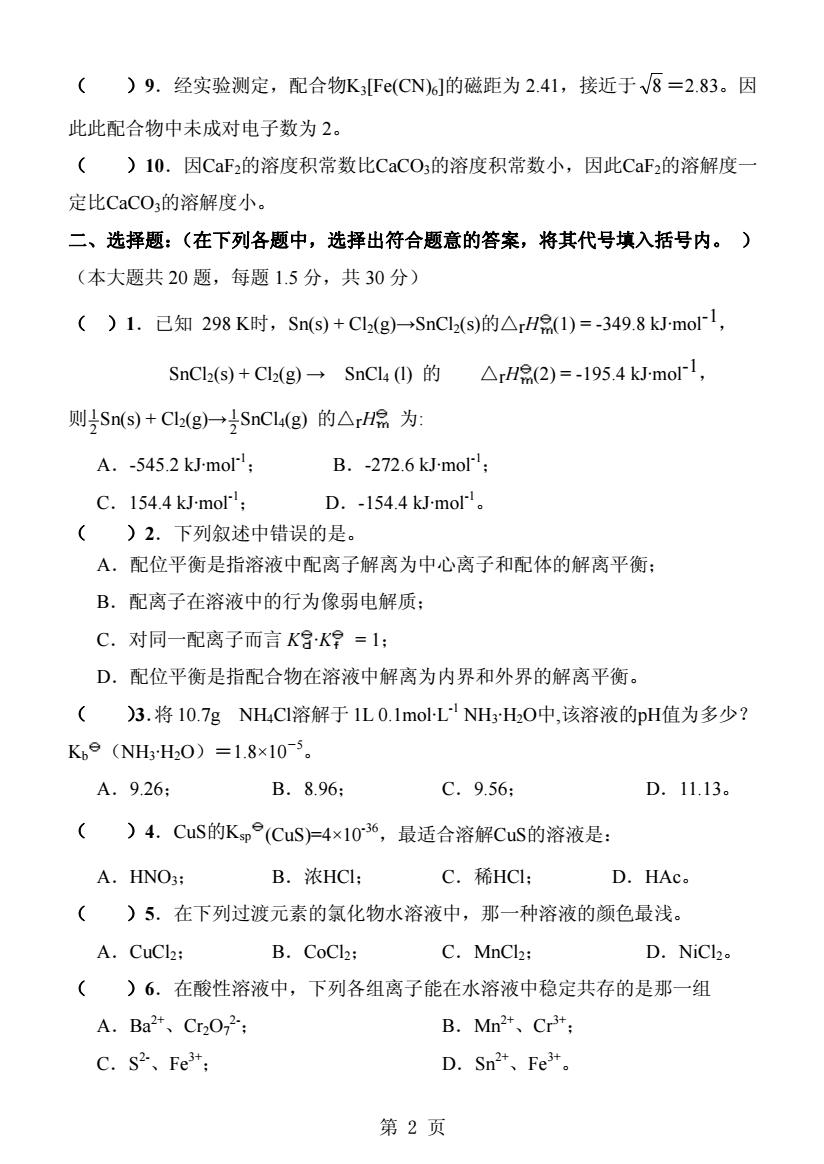
()9.经实验测定,配合物KF(CN6的磁距为2.41,接近于√⑧=2.83。因 此此配合物中未成对电子数为2。 ()10.因CaF2的溶度积常数比CaCO3的溶度积常数小,因此CaF2的溶解度 定比CaCO3的溶解度小。 二、选择题:(在下列各题中,选择出符合题意的答案,将其代号填入括号内。) (本大题共20题,每题1.5分,共30分) ()1.己知298K时,Sn(s)+Cl2(g)→SnCl2(s)的△rH(1)=-349.8 kJmol, SnCl2(s)+Cl(g)→SnCl4①的 △rH(2)=-195.4kJmo1 则Sn(s)+Cl(g)→SnCl4(g)的△rH为 A.-545.2 kJ-mol!: B.-272.6 kJ-mol"; C.154.4 kJ-mol; D.-154.4kmo。 ()2.下列叙述中错误的是。 A.配位平衡是指溶液中配离子解离为中心离子和配体的解离平衡: B.配离子在溶液中的行为像弱电解质; C.对同一配离子而言KK?=1: D.配位平衡是指配合物在溶液中解离为内界和外界的解离平衡。 ()3.将10.7gNH,CI溶解于1L0.1 mol-L NH3H2O中,该溶液的pH值为多少? K,9(NH3H0)=1.8×10-5。 A.9.26: B.8.96: C.9.56 D.11.13. ()4.CuS的Kp°(CuS)=4×1036,最适合溶解CuS的溶液是: A.HNO3; B.浓HC:C.稀HC1 D.HAc. ()5.在下列过渡元素的氯化物水溶液中,那一种溶液的颜色最浅。 A.CuCl2; B.CoCl2:C.MnCl2: D.NiCl2 ()6.在酸性溶液中,下列各组离子能在水溶液中稳定共存的是那一组 A.Ba2+、Cr0,2: B.Mn2+、Cr3t: C.s2、Fet; D.Sn2+、Fe3+。 第2页
( )9.经实验测定,配合物K3[Fe(CN)6]的磁距为 2.41,接近于 8 =2.83。因 此此配合物中未成对电子数为 2。 ( )10.因CaF2的溶度积常数比CaCO3的溶度积常数小,因此CaF2的溶解度一 定比CaCO3的溶解度小。 二、选择题:(在下列各题中,选择出符合题意的答案,将其代号填入括号内。 ) (本大题共 20 题,每题 1.5 分,共 30 分) ( )1.已知 298 K时,Sn(s) + Cl2(g)→SnCl2(s)的△rH (1) = -349.8 kJ·mol-1, SnCl2(s) + Cl2(g) → SnCl4 (l) 的 △rH (2) = -195.4 kJ·mol-1, 则1 2 Sn(s) + Cl2(g)→1 2 SnCl4(g) 的△rH 为: A.-545.2 kJ·mol-1 ; B.-272.6 kJ·mol-1 ; C.154.4 kJ·mol-1 ; -1 D.-154.4 kJ·mol 。 ( )2.下列叙述中错误的是。 A.配位平衡是指溶液中配离子解离为中心离子和配体的解离平衡; B.配离子在溶液中的行为像弱电解质; C.对同一配离子而言 K ·K = 1; D.配位平衡是指配合物在溶液中解离为内界和外界的解离平衡。 ( )3.将 10.7g NH Cl溶解于 1L 0.1mol·L-1 4 NH3·H2O中,该溶液的pH值为多少? Kb (NH3·H2O)=1.8×10-5 。 A.9.26; B.8.96; C.9.56; D.11.13。 ( )4.CuS的Ksp (CuS)=4×10-36,最适合溶解CuS的溶液是: A.HNO3; B.浓HCl; C.稀HCl; D.HAc。 ( )5.在下列过渡元素的氯化物水溶液中,那一种溶液的颜色最浅。 A.CuCl2; B.CoCl2; C.MnCl2; D.NiCl2。 ( )6.在酸性溶液中,下列各组离子能在水溶液中稳定共存的是那一组 2+ 2- A.Ba 、Cr2O7 ; B.Mn2+、 3+ Cr ; C.S2-、 3+ 2+ Fe ; D.Sn 、Fe3+。 第 2 页
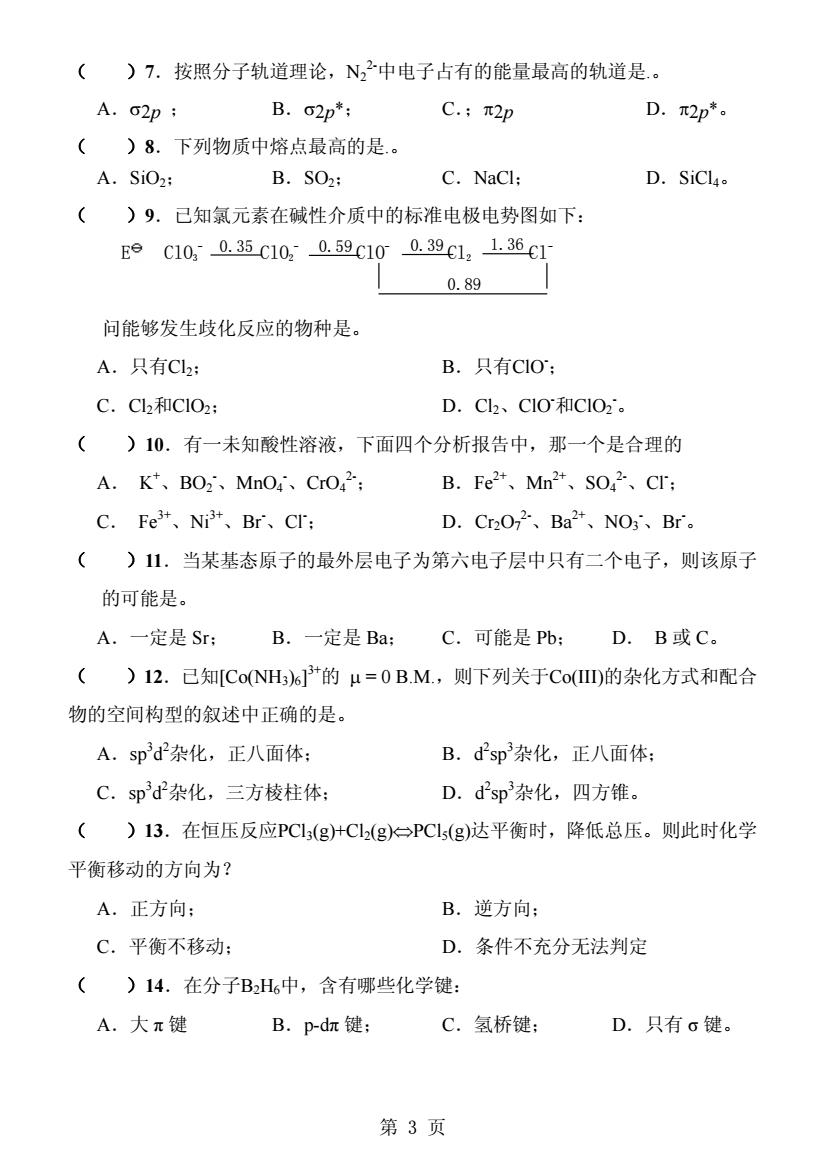
()7.按照分子轨道理论,N22中电子占有的能量最高的轨道是. A.2p B.2p*: C.:2p D.2p*。 ()8.下列物质中熔点最高的是.。 A.SiO2: B.SO2; C.NaCl: D.SiCl4 ()9.己知氯元素在碱性介质中的标准电极电势图如下: E9C10s0.35C100.59c100.39c1,1.36c1 0.89 问能够发生歧化反应的物种是。 A.只有Cl2: B.只有CIO: C.Cl2和C1O2: D.C2、C1O和C1O2。 ()10.有一未知酸性溶液,下面四个分析报告中,那一个是合理的 A.K、BO2、MnO4、CrO42; B.Fe2+、Mn2+、S042、CIr: C.Fe3+、Ni3+、Br、CIr: D.Cr2O2、Ba2+、NO3、Br。 ()11.当某基态原子的最外层电子为第六电子层中只有二个电子,则该原子 的可能是。 A.一定是Sr:B.一定是Ba:C.可能是Pb:D.B或C。 ()12.己知[CoNH6的μ=0B.M,则下列关于Co(D的杂化方式和配合 物的空间构型的叙述中正确的是。 A.spd杂化,正八面体: B.dsp杂化,正八面体: C.sp3d杂化,三方棱柱体 D.d2sp杂化,四方锥。 ()13.在恒压反应PC1(g+C1(g)一PC1s(g)达平衡时,降低总压。则此时化学 平衡移动的方向为? A.正方向: B.逆方向; C.平衡不移动: D.条件不充分无法判定 ()14.在分子BH6中,含有哪些化学键: A.大π键 B.p-dr键; C.氢桥键: D.只有o键。 第3页
( ) 2- 7.按照分子轨道理论,N2 中电子占有的能量最高的轨道是.。 A.σ2p ; B.σ2p *; C.;π2p D.π2p *。 ( )8.下列物质中熔点最高的是.。 A.SiO2; B.SO2; C.NaCl; D.SiCl4。 ( )9.已知氯元素在碱性介质中的标准电极电势图如下: E ClO3 - ClO2 - ClO- Cl2 Cl 0.35 0.59 0.39 1.36 - 0.89 问能够发生歧化反应的物种是。 A.只有Cl ; B.只有ClO 2 - ; C.Cl2和ClO2; D.Cl2、ClO- 和 - ClO2 。 ( )10.有一未知酸性溶液,下面四个分析报告中,那一个是合理的 A. K+ 、 - - 2- 2+ BO2 、MnO4 、CrO4 ; B.Fe 、Mn2+、 2- - SO4 、Cl ; 3+ 3+ - - 2- 2+ - - C. Fe 、Ni 、Br 、Cl ; D.Cr2O7 、Ba 、NO3 、Br 。 ( )11.当某基态原子的最外层电子为第六电子层中只有二个电子,则该原子 的可能是。 A.一定是 Sr; B.一定是 Ba; C.可能是 Pb; D. B 或 C。 ( )12.已知[Co(NH3) ] 3+ 6 的 μ = 0 B.M.,则下列关于Co(III)的杂化方式和配合 物的空间构型的叙述中正确的是。 A.sp3 d2 杂化,正八面体; B.d2 sp3 杂化,正八面体; C.sp3 d2 杂化,三方棱柱体; D.d2 sp3 杂化,四方锥。 ( )13.在恒压反应PCl3(g)+Cl2(g)⇔PCl5(g)达平衡时,降低总压。则此时化学 平衡移动的方向为? A.正方向; B.逆方向; C.平衡不移动; D.条件不充分无法判定 ( )14.在分子BB 2H6中,含有哪些化学键: A.大 π 键 B.p-dπ 键; C.氢桥键; D.只有 σ 键。 第 3 页
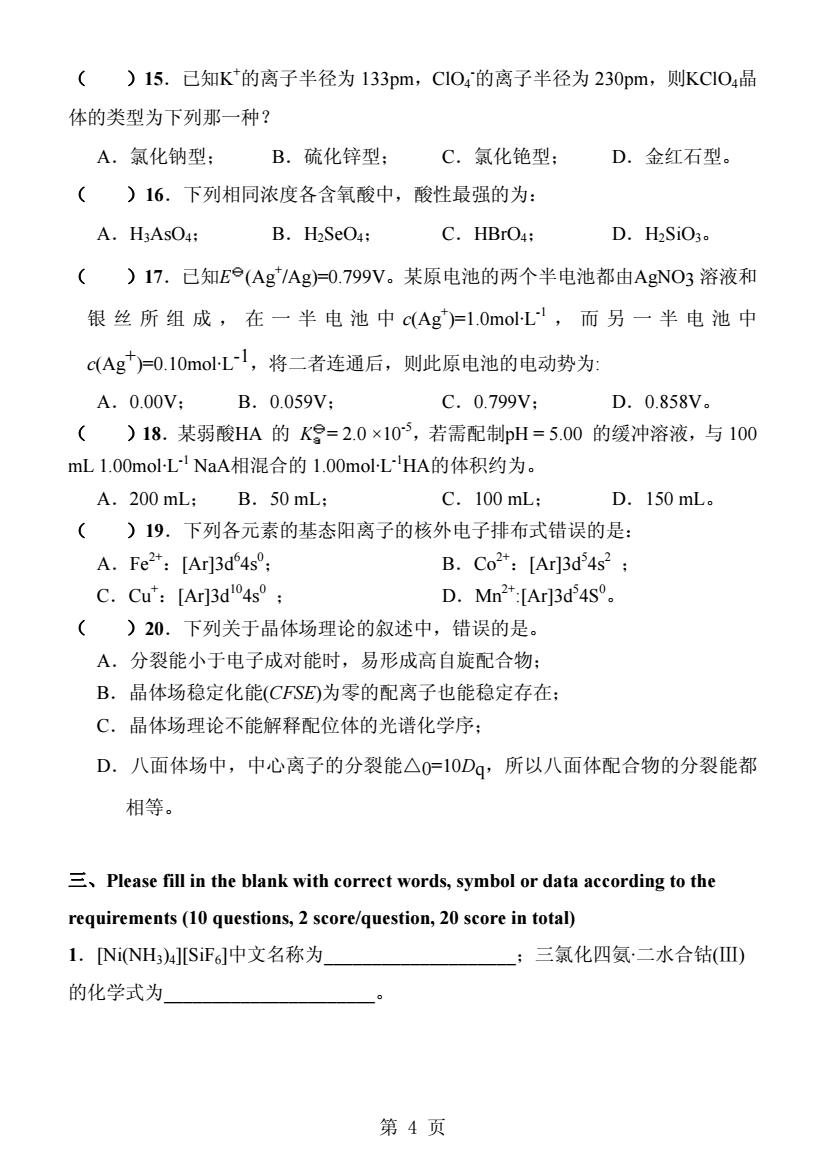
()15.己知K的离子半径为133pm,C1O4的离子半径为230pm,则KC1O4晶 体的类型为下列那一种? A.氯化钠型:B.硫化锌型: C.氯化铯型: D.金红石型。 ()16.下列相同浓度各含氧酸中,酸性最强的为: A.H3AsO4: B.H2SeO4: C.HBrO4: D.H2SiO3 ()17.己知E(Ag1Ag)=0.799V。某原电池的两个半电池都由AgNO3溶液和 银丝所组成,在一半电池中c(Ag)=1.0moL,而另一半电池中 c(Ag=0.10molL1,将二者连通后,则此原电池的电动势为: A.0.00V:B.0.059V: C.0.799V: D.0.858V。 ()18.某弱酸HA的K9=2.0×10,若需配制H=5.00的缓冲溶液,与100 mL1.00molL1NaA相混合的1.00 mol-LHA的体积约为。 A.200mL:B.50mL: C.100mL: D.150mL. ()19.下列各元素的基态阳离子的核外电子排布式错误的是: A.Fe2:[Ar]3d4s: B.Co2:[Ar]3d34s2 C.Cu:[Ar]3d104s°: D.Mn2+[Ar3d4s。 ()20.下列关于晶体场理论的叙述中,错误的是 A.分裂能小于电子成对能时,易形成高自旋配合物: B.晶体场稳定化能(CFSE为零的配离子也能稳定存在: C.晶体场理论不能解释配位体的光谱化学序: D.八面体场中,中心离子的分裂能△0=10Dg,所以八面体配合物的分裂能都 相等 Please fill in the blank with correct words,symbol or data according to the requirements(10 questions,2 score/question,20 score in total) 1.NiNH)4]SiF中文名称为 三氯化四氨·二水合钻) 的化学式为 第4页
( )15.已知K+ 的离子半径为 - 133pm,ClO4 的离子半径为 230pm,则KClO4晶 体的类型为下列那一种? A.氯化钠型; B.硫化锌型; C.氯化铯型; D.金红石型。 ( )16.下列相同浓度各含氧酸中,酸性最强的为: A.H3AsO4; B.H2SeO4; C.HBrO4; D.H2SiO3。 ( ) + 17.已知E (Ag /Ag)=0.799V。某原电池的两个半电池都由AgNO3 溶液和 银丝所组成,在一半电池中 c(Ag+ )=1.0mol·L-1 ,而另一半电池中 c(Ag+)=0.10mol·L-1,将二者连通后,则此原电池的电动势为: A.0.00V; B.0.059V; C.0.799V; D.0.858V。 ( )18.某弱酸HA 的 K = 2.0 ×10-5,若需配制pH = 5.00 的缓冲溶液,与 100 mL 1.00mol·L-1 NaA相混合的 1.00mol·L-1HA的体积约为。 A.200 mL; B.50 mL; C.100 mL; D.150 mL。 ( )19.下列各元素的基态阳离子的核外电子排布式错误的是: 2+ 6 0 2+ 5 2 A.Fe :[Ar]3d 4s ; B.Co :[Ar]3d 4s ; + 10 0 C.Cu :[Ar]3d 4s ; D.Mn2+:[Ar]3d5 4S0 。 ( )20.下列关于晶体场理论的叙述中,错误的是。 A.分裂能小于电子成对能时,易形成高自旋配合物; B.晶体场稳定化能(CFSE)为零的配离子也能稳定存在; C.晶体场理论不能解释配位体的光谱化学序; D.八面体场中,中心离子的分裂能△0=10Dq,所以八面体配合物的分裂能都 相等。 三、Please fill in the blank with correct words, symbol or data according to the requirements (10 questions, 2 score/question, 20 score in total) 1.[Ni(NH3)4][SiF6]中文名称为____________________;三氯化四氨·二水合钴(Ⅲ) 的化学式为______________________。 第 4 页
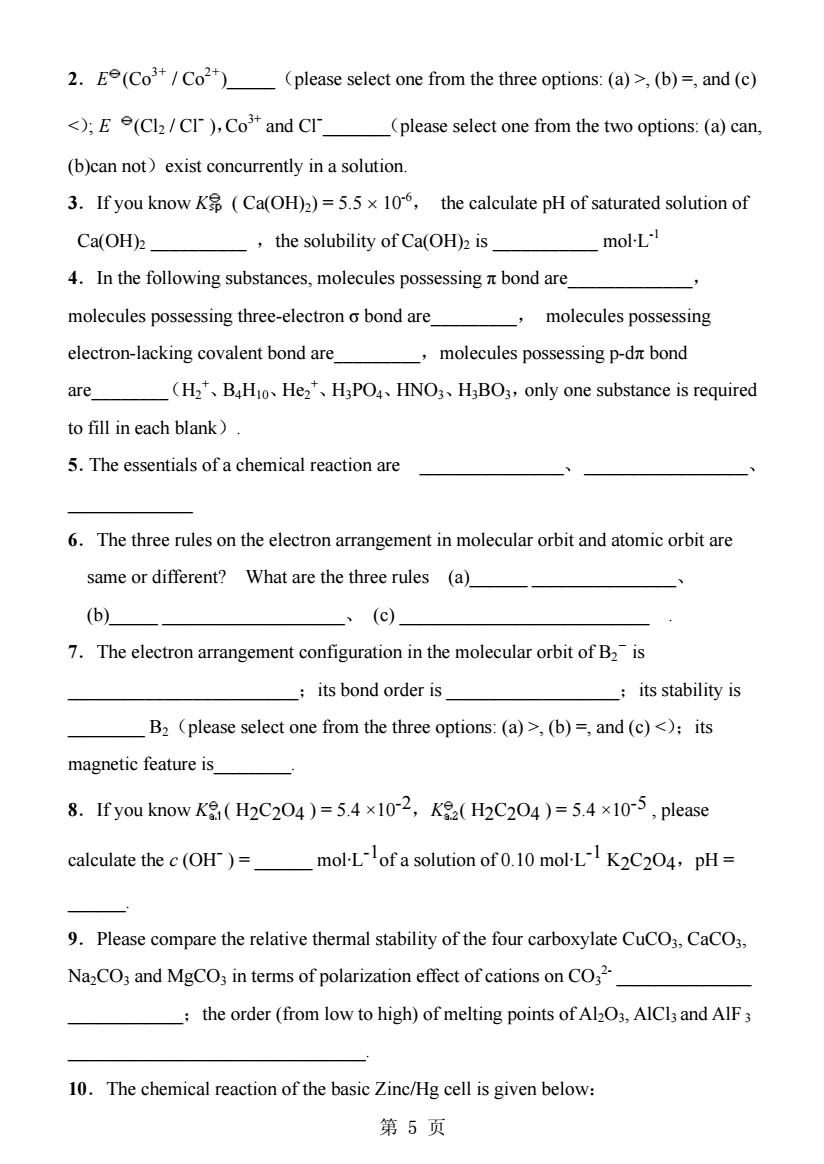
2.E(Co/Co+)(please select one from the three options:(a)>,(b)=,and (c) ,(b)=,and (c)<):its magnetic feature is_ 8.If you know K(H2C204)=5.4×102,K82(H2C204)=5.4×105,please calculate the c(OH)= mol-L-of a solution of 0.10 mol-L K2C204,pH= 9.Please compare the relative thermal stability of the four carboxylate CucO3,CaCO3. NazCO,and MgCO,in terms of polarization effect of cations on CO,2 the order(from low to high)of melting points of Al2O3,AICl;and AlF3 10.The chemical reaction of the basic Zinc/Hg cell is given below: 第5页
2.E (Co3+ 2+ / Co )_____(please select one from the three options: (a) >, (b) =, and (c) , (b) =, and (c) <);its magnetic feature is________. 8.If you know K ( H2C2O4 ) = 5.4 ×10-2,K ( H2C2O4 ) = 5.4 ×10-5 , please calculate the c (OH- ) = ______ mol·L-1of a solution of 0.10 mol·L-1 K2C2O4,pH = ______. 9.Please compare the relative thermal stability of the four carboxylate CuCO3, CaCO3, Na 2- 2CO3 and MgCO3 in terms of polarization effect of cations on CO3 ______________ ____________;the order (from low to high) of melting points of Al2O3, AlCl3 and AlF 3 _______________________________. 10.The chemical reaction of the basic Zinc/Hg cell is given below: 第 5 页
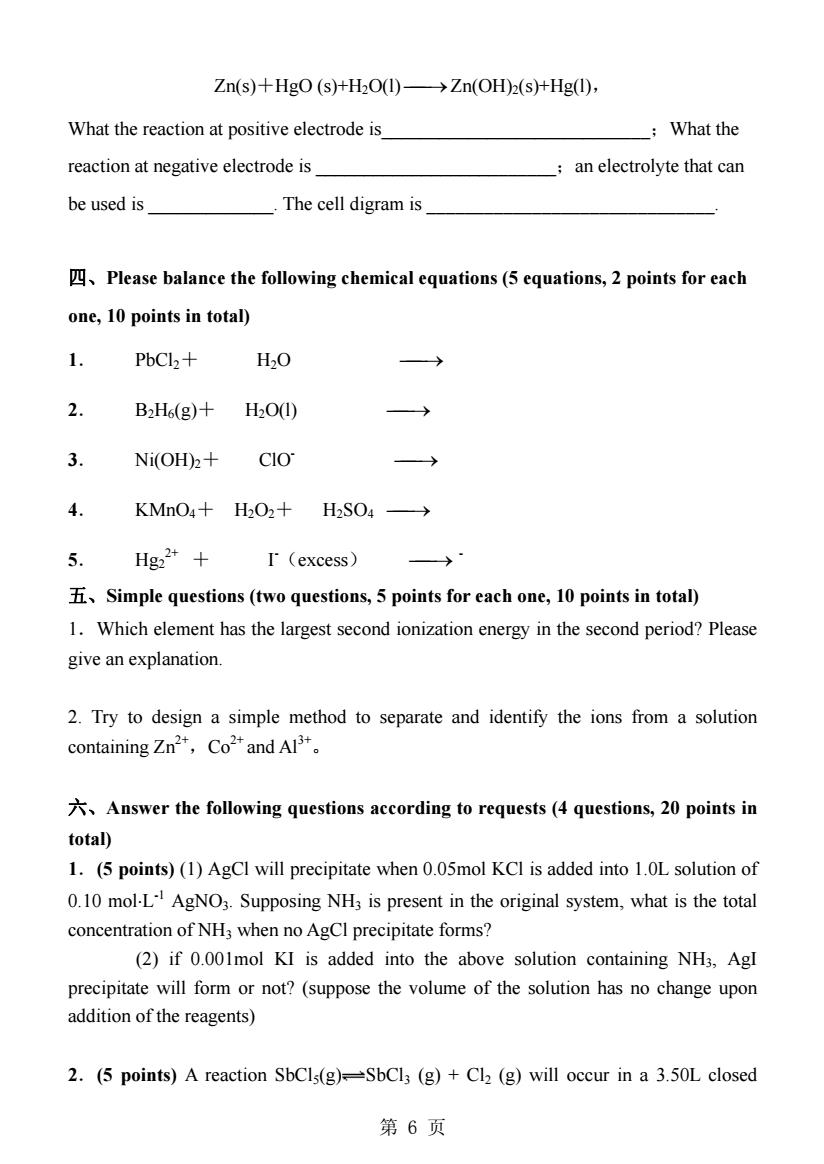
Zn(s)+HgO(s)+H2O(I)->Zn(OH)2(s)+Hg(I), What the reaction at positive electrode is What the reaction at negative electrode is an electrolyte that can be used is The cell digram is Please balance the following chemical equations(5 equations,2 points for each one,10 points in total) PbCl+ H20 —→ 2. B2H6(g)+H2O(1) → Ni(OH)2+ CIO 4. KMnO4+H2O2+HSO4—→ 5. Hg22++ I'(excess) Simple questions(two questions,5 points for each one,10 points in total) 1.Which element has the largest second ionization energy in the second period?Please give an explanation. 2.Try to design a simple method to separate and identify the ions from a solution containing Zn,Coand Al. Answer the following questions according to requests(4 questions,20 points in total) 1.(5 points)(1)AgCl will precipitate when 0.05mol KCl is added into 1.0L solution of 0.10 mol-L AgNO3.Supposing NH3 is present in the original system,what is the total concentration of NH,when no AgCl precipitate forms? (2)if 0.001mol KI is added into the above solution containing NH3,Agl precipitate will form or not?(suppose the volume of the solution has no change upon addition of the reagents) 2.(5 points)A reaction SbCls(g)=SbCl3(g)+Cl2(g)will occur in a 3.50L closed 第6页
Zn(s)+HgO (s)+H2O(l) ⎯⎯→Zn(OH)2(s)+Hg(l), What the reaction at positive electrode is____________________________;What the reaction at negative electrode is _________________________;an electrolyte that can be used is _____________. The cell digram is ______________________________. 四、Please balance the following chemical equations (5 equations, 2 points for each one, 10 points in total) 1. PbCl2+ H2O ⎯⎯→ 2. B2H6(g)+ H2O(l) ⎯⎯→ 3. Ni(OH)2+ ClO- ⎯⎯→ 4. KMnO4+ H2O2+ H2SO4 ⎯⎯→ 2+ 5. Hg2 + I- (excess) ⎯⎯→ - 五、Simple questions (two questions, 5 points for each one, 10 points in total) 1.Which element has the largest second ionization energy in the second period? Please give an explanation. 2. Try to design a simple method to separate and identify the ions from a solution containing Zn2+, 2+ 3+ Co and Al 。 六、Answer the following questions according to requests (4 questions, 20 points in total) 1.(5 points) (1) AgCl will precipitate when 0.05mol KCl is added into 1.0L solution of 0.10 mol⋅L-1 AgNO3. Supposing NH3 is present in the original system, what is the total concentration of NH3 when no AgCl precipitate forms? (2) if 0.001mol KI is added into the above solution containing NH3, AgI precipitate will form or not? (suppose the volume of the solution has no change upon addition of the reagents) 2.(5 points) A reaction SbCl5(g) SbCl3 (g) + Cl2 (g) will occur in a 3.50L closed 第 6 页
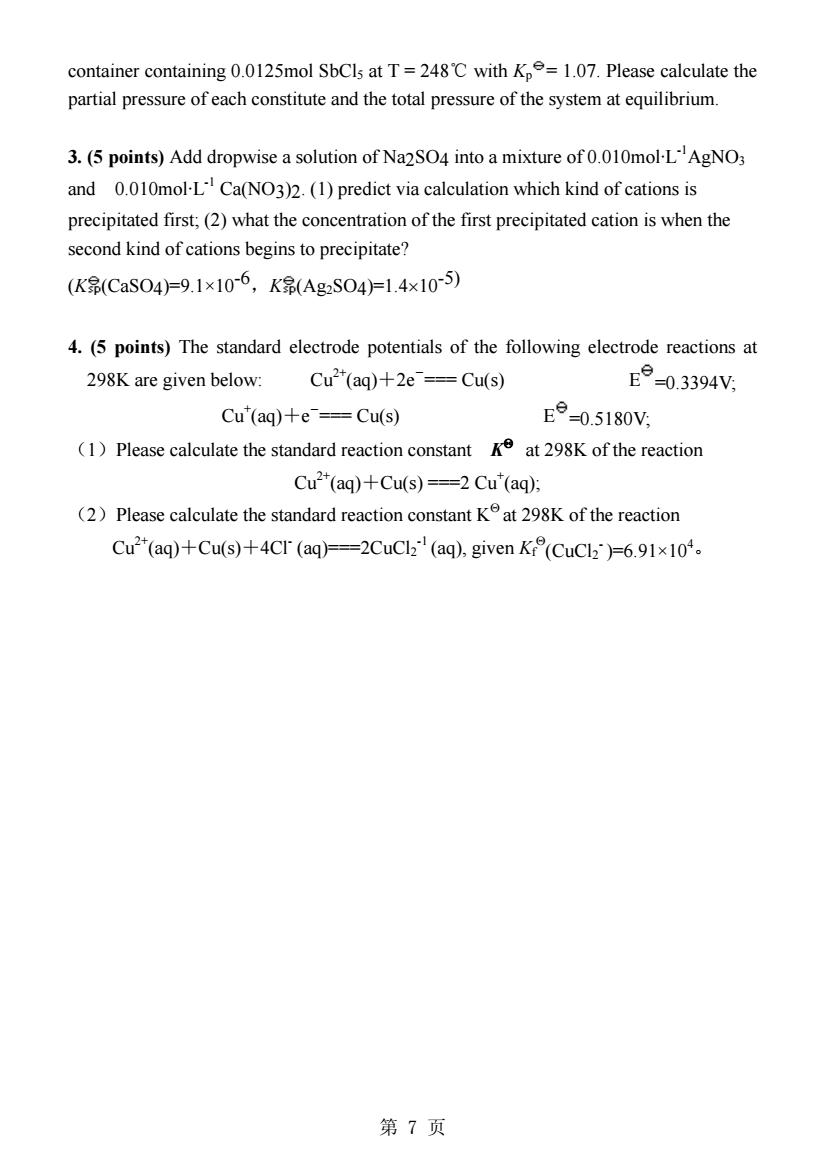
container containing 0.0125mol SbCls at T=248C with Kp=1.07.Please calculate the partial pressure of each constitute and the total pressure of the system at equilibrium. 3.(5 points)Add dropwise a solution of Na2SO4 into a mixture of 0.010mol-LAgNO3 and 0.010mol-L Ca(NO3)2.(1)predict via calculation which kind of cations is precipitated first,(2)what the concentration of the first precipitated cation is when the second kind of cations begins to precipitate? (K绵(CaS04)=9.1x10-6,K绵(AgS04F1.4x105) 4.(5 points)The standard electrode potentials of the following electrode reactions at 298K are given below:Cu"(aq)+2e=Cu(s) E6=0.3394V Cu'(aq)+e ==Cu(s) E9-0.5180V (1)Please calculate the standard reaction constantKe at 298K of the reaction Cu(aq)+Cu(s)===2 Cu"(aq); (2)Please calculate the standard reaction constant Kat 298K of the reaction Cu(aq)+Cu(s)+4CI (aq)==2CuClz(aq),given Kr(CuCl2")=6.91x10. 第7页
container containing 0.0125mol SbCl5 at T = 248℃ with Kp = 1.07. Please calculate the partial pressure of each constitute and the total pressure of the system at equilibrium. 3. (5 points) Add dropwise a solution of Na2SO4 into a mixture of 0.010mol·L-1AgNO3 and 0.010mol·L-1 Ca(NO3)2. (1) predict via calculation which kind of cations is precipitated first; (2) what the concentration of the first precipitated cation is when the second kind of cations begins to precipitate? (K (CaSO4)=9.1×10-6,K SO4)=1.4×10-5) (Ag2 4. (5 points) The standard electrode potentials of the following electrode reactions at 298K are given below: Cu2+(aq)+2e- === Cu(s) E =0.3394V; Cu+ (aq)+e - === Cu(s) E =0.5180V; (1)Please calculate the standard reaction constant KΘ at 298K of the reaction 2+ + Cu (aq)+Cu(s) ===2 Cu (aq); (2)Please calculate the standard reaction constant KΘ at 298K of the reaction 2+ Cu (aq)+Cu(s)+4Cl- -1 (aq)===2CuCl2 (aq), given Kf Θ (CuCl - )=6.91×104。 2 第 7 页